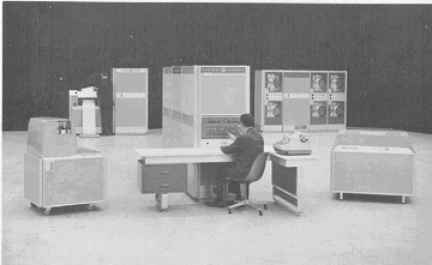
The GE-200 product originated in the early days of the Computer Department in Phoenix AZ.
In fact, the GE-200 name has been also used for banking products derived from the first GE computer, the ERMA project, General Electric marketed in the early 60s the GE200 Bank Transit system aaorund a document (check) sorting system.
Three variations of the same central processor constitutes that product line sold between 1959 ? and 1966.
GE-225
GE 235
GE-215
The GE-225 was derived from the GE-312 and 412 Process control computers, then part of the Computer Department products. It was designed by Arnold Spielberg and Chuck Prosper, ex-RCA engineers who have been working on BIZMAC. It was introduced in 1960.

The GE-225 was a 20-bits word binary machine with 3 hardware
registers not specially designed for business applications.
The instruction of 20-bits contains a 5-bits OP code, 2-bits of address
modification and 13-bits of operand address
Floating Point is a harware option. Decimal arithmetic (with 3 6-bits BCD numbers per word
, is another option. Real-Time clock, Move command was also an optional feature
Addition was performed in 36 Ás. Multiplication in 288 Ás and Division in 495Ás
Technology was solid-state (diodes and transistors). A 8K words system contained 1,000 circuit boards, 10,000 transistors, 20,000 diodes and 186,000 magnetic cores.The power dissipation was 16 KVA.
Main memory was offered in 4, 8 and 16K words.Its access time was 18 Ás.
Peripherals included:
Disks (MRADS Mass Random Access Data Storage) 98304 words per unit,
thruput 62.5Kcps, up to 32 units.
Magnetic Tapes at 200 and 556 bpi operating at 75ips
Card reader 400 or 1000 cpm
Card punch 100 or 300 cpm
Paper Tape reader at 250 or 1000 cps
Paper Tape punch 110 cps
Line Printer 900 lpm 160 columns
Datanet 15 single communication line controller 75 to 1600 bps
Datanet 30 communications processor
Check sorter 1200 dpm
Typewriter 10 cps
Up to 11 devices may operate simultaneously, through independent channels connected to the memory by an autonomous "controller selector". Unit record devices operated under processor control.
Software includes a compiler of GECOM language (a COBOL dialect with many ALGOL features), TABSOL (a language based on decision tables), WIZ (a Algebraic compiler), FORTRAN II, GAP a translator for IBM 650 and LGP30 and a Report Generator.
Charlie Bachmann develops the IDS data base system for the GE-225 before it was ported to GE-400 and GE-600
One of the major initial customers was at Huntsville Arsenal, a NASA predecessor)
The GE-215 was a scaled-down version of the GE-225. The number of channels was reduced to 6.The main core memory was limited to 4K and 8K words.
Addition was performed in 72 Ás. Multiplication in 342 Ás and Division in 531 Ás
The GE-235 was a re-implementation (three times faster) of the GE-225 with a faster memory (cycle 5 Ás) designed in 1962 and delivered in 1964.
Addition was performed in 12 Ás. Multiplication in 84
Ás and Division in 85 Ás, thanks to a new high-speed arithmetic unit.
More I/O operations can operate simultaneously through a second access controller
The GE-265 that was the system running the first
commercial time-sharing system is the association of a GE-235 processor and of a
Datanet-30 communication processor.
The software was designed at Dartmouth College as DTSS in 1963-1964.While BASIC was the
main programming language created for that system, it was also used in ALGOL and Fortran.
A peculiarity of the DTSS was that the main part of the operating system was resident in
the DN-30 front-end processor and that only the user programs and their environment
(e.g.the BASIC interpreter) were executed in the GE-235. The two processors were
interconnected through a direct interface and were sharing a disc unit DS-20.
A contemporary (1964) description of the system will be available here
This system was introduced by GE and by Bull-General Electric in 1965

a Teletype 33 DTSS terminal at Bull-GE in 1966
The GE-265 operating system was renamed Mark I and was later (1968) ported on GE-635 as Mark II and Mark III, by General Electric Information Services Division that was not transferred to Honeywell in 1970
Note: The ERMA machine developed for the Bank of America and NCR (NCR 304) has got also the name of GE-210 when sold to other banks than BoA, and GE-304B when used internally at General Electric . It is not part of "Compatibles GE-200."
Revision: 07 mai 2003